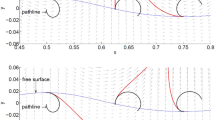Abstract
Large amplitude sloshing in tanks is simulated by the least square particle finite element method (LSPFEM) in this paper. The least square finite element method (LSFEM) is employed to spatially discrete the Navier–Stokes equations, and to avoid the stabilization issues due to the incompressibility condition for equal-order interpolation of the velocity and the pressure, as usually used in Galerkin method to satisfy the well-known LBB condition. The LSPFEM also uses the Lagrangian description to model the motion of nodes (particles). A mesh which connects these nodes is constructed by a triangulation algorithm to avoid the mesh distortion. A quasi α-shapes algorithm is used to identify the free surface boundary. The nodes are viewed as particles which can freely move and even separate from the main fluid domain. Finally this method is used to study the large amplitude sloshing evolution in two dimensional tanks. The results are compared with those obtained by Flow-3d with good agreement.
Similar content being viewed by others
References
Codina, R.: Pressure stability in fractional step finite element methods for incompressible flows. J. Comput. Phys. 170(1), 112–140 (2001)
Renardy, Y.Y., Renardy, M., Cristini, V.: A new volume-of-fluid formulation for surfactants and simulations of drop deformation under shear at a low viscosity ratio. Eur. J. Mech. B Fluids 21(1), 49–59 (2002)
Scardovelli, R., Zaleski, S.: Direct numerical simulation of free-surface and interfacial flow. Ann. Rev. Fluid Mech. 31, 567–603 (1999)
Yue, B., Wang, Z.: Numerical study of three-dimensional free surface dynamics. Acta Mech. Sinica 22, 120–125 (2006)
Idelsohn, S.R., Onate, E., Del Pin, F.: The particle finite element method: a powerful tool to solve incompressible flows with free-surfaces and breaking waves. Int. J. Numer. Methods Eng. 61, 964–989 (2004)
Calvo, N., Idelsohn, S.R., Onate, E.: The extended delaunay tessellation. Eng. Comput. 20, 583–600 (2003)
Jiang, B.N.: The Least-Squares Finite Element Method: Theory and Applications in Computational Fluid Dynamics and Electromagnetics. Springer, Berlin (1998)
Donea, J., Huerta, A.: Finite Element Methods for Flow Problems. Wiley, New York (2003)
Oliver, K.H.: Least-Squares Methods for the Solution of Fluid-Structure Interaction Problems. Technische UniBraunschweig Inst. f. angew. Mechanik (2006)
Deang, J.M., Gunzburger, M.D.: Issues related to least-squares finite element methods for the stokes equations. SIAM J. Sci. Comput. 20(3), 878–906 (1998)
Bowyer, A.: Computing dirichlet tessellations. Comput. J. 24, 162–166 (1981)
Idelsohn, S.R., Onate, E., Calvo, N., Del Pin, F.: Meshless finite element ideas. In: Fifth World Congress on Computational Mechanics (2002)
Edelbrunner, H., Muecke, E.: Three-dimensional alpha shape. ACM Trans. Graphics 13, 43–72 (1994)
Yamamoto, K., Kawahara, M.: Structural oscillation control using tuned liquid damper. Comput. Struct. 71, 435–446 (1999)
Royon-Lebeaud, A., Hopfinger, E.J., Cartellier, A.: Liquid sloshing and wave breaking in circular and square-base cylindrical containers. J. Fluid Mech. 57, 467–494 (2007)
Author information
Authors and Affiliations
Corresponding author
Additional information
The project supported by the National Natural Science Foundation of China (10302013, 10572022).
The English text was polished by Keren Wang.
Rights and permissions
About this article
Cite this article
Tang, B., Li, J. & Wang, T. The least square particle finite element method for simulating large amplitude sloshing flows. Acta Mech Sin 24, 317–323 (2008). https://doi.org/10.1007/s10409-008-0144-3
Received:
Revised:
Accepted:
Published:
Issue Date:
DOI: https://doi.org/10.1007/s10409-008-0144-3




